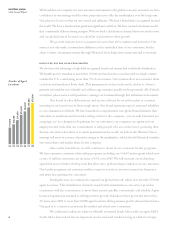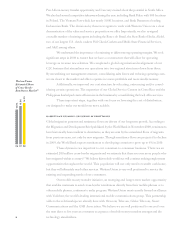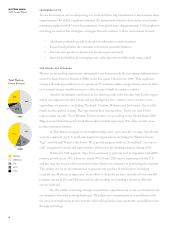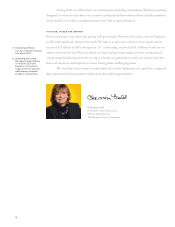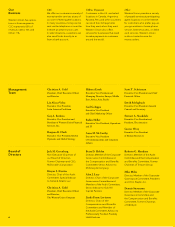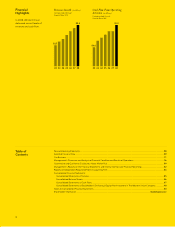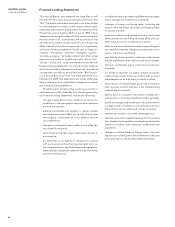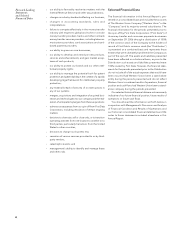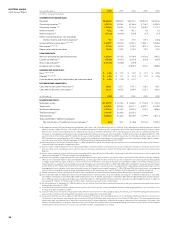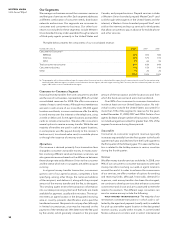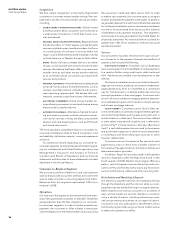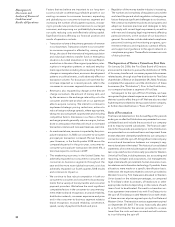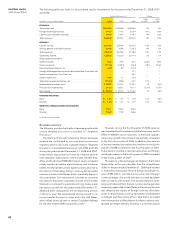Western Union 2008 Annual Report Download - page 14
Download and view the complete annual report
Please find page 14 of the 2008 Western Union annual report below. You can navigate through the pages in the report by either clicking on the pages listed below, or by using the keyword search tool below to find specific information within the annual report.
WESTERN UNION
2008 Annual Report
12
Consumer-to-Consumer Segment
Individual money transfers from one consumer to another
are the core of our business, representing 85% of our total
consolidated revenues for 2008. We offer consumers a
variety of ways to send money. Although most remittances
are sent in cash at one of our more than 375,000 agent
locations worldwide, in some countries we offer the ability
to send money over the internet or the telephone, using
a credit or debit card. Some agent locations accept debit
cards to initiate a transaction. We also offer consumers
several options to receive a money transfer. While the vast
majority of transfers are paid in cash at agent locations,
in some places we offer payout directly to the receiver’s
bank account, to a stored-value card, to a mobile phone
or through the issuance of a money order.
Operations
Our revenue is derived primarily from transaction fees
charged to consumers to transfer money. In money trans-
fers involving different send and receive currencies, we
also generate revenue based on the difference between
the exchange rate set by Western Union to the consumer
and the rate at which we or our agents are able to acquire
currency.
In a typical money transfer transaction, a consumer
goes to one of our agent locations, completes a form
specifying, among other things, the name and address
of the recipient, and delivers it, along with the principal
amount of the money transfer and the fee, to the agent.
This sending agent enters the transaction information
into our data processing system and the funds are made
available for payment, usually within minutes. The recipi-
ent enters an agent location in the designated receiving
area or country, presents identification and is paid the
transferred amount. Recipients do not pay a fee (although
in limited circumstances, a tax may be imposed on the
payment of the remittance). We determine the fee paid
by the sender, which generally is based on the principal
amount of the transaction and the locations to and from
which the funds are sent and are to be transferred.
Over 85% of our consumer-to-consumer transactions
involve at least one non-United States location. No indi-
vidual country outside the United States accounted for
more than 10% of the segment’s revenue for the years
ended December 31, 2008, 2007 and 2006. Certain of our
agents facilitate a large number of transactions; however,
no individual agent accounted for greater than 10% of the
segment’s revenue during these periods.
Seasonality
Consumer-to-consumer segment revenue typically
increases sequentially from the first quarter to the fourth
quarter each year and declines from the fourth quarter to
the first quarter of the following year. This seasonal fluctua-
tion is related to the holiday season in various countries
during the fourth quarter.
Services
We offer money transfer services worldwide. In 2008, over
90% of our consumer-to-consumer transactions were cash
money transfers involving our walk-in agent locations
around the world. In order to enhance the convenience
of our services, we offer a number of options for sending
and receiving funds; although, historically, demand for
in-person, cash money transfers has been the strongest,
we continue to develop services that enhance consumer
convenience and choice and are customized to meet the
needs of consumers. The different ways consumers can
send or receive money include the following:
WALK-IN MONEY TRANSFER SERVICE—
The majority of our
remittances constitute transactions in which cash is col-
lected by the agent and payment (usually cash) is available
for pick-up at another agent location in the designated
receive country, usually within minutes. In some United
States outbound corridors and in select international
12
Our Segments
We manage our business around the consumers we serve
and the type of services we offer. Each segment addresses
a different combination of consumer needs, distribution
networks and services. Our segments are consumer-to-
consumer and consumer-to-business. Our other busi-
nesses not included in these segments include Western
Union branded money orders available through a network
of third-party agents primarily in the United States and
Canada, and prepaid services. Prepaid services include
a Western Union branded prepaid MasterCard® card
sold through select agents in the United States and the
internet, a Western Union branded prepaid Visa® card
sold on the internet, and top-up services for third parties
that allow consumers to pay in advance for mobile phone
and other services.
The table below presents the components of our consolidated revenue:
Year Ended December 31, 2008 2007 2006
Consumer-to-Consumer (a)
EMEASA 44% 40% 38%
Americas 34% 37% 41%
APAC 7% 6% 5%
Total consumer-to-consumer 85% 83% 84%
Consumer-to-business 14% 15% 14%
Other 1% 2% 2%
100% 100% 100%
(a) The geographic split is determined based upon the region where the money transfer is initiated and the region where the money transfer is paid. For transactions origi-
nated and paid in different regions, we split the revenue between the two regions, with each region receiving 50%. For money transfers initiated and paid in the same
region, 100% of the revenue is attributed to that region.


